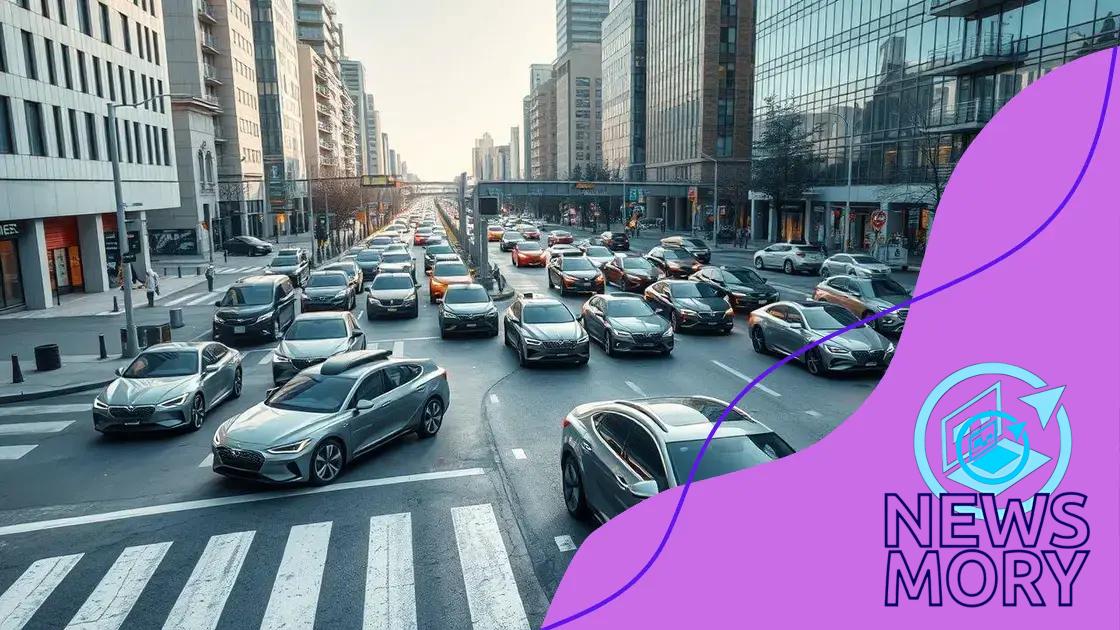The role of autonomous vehicles in reducing traffic congestion

Anúncios
The role of autonomous vehicles in reducing traffic congestion includes enhancing road safety, optimizing travel times, and facilitating shared transportation options, leading to a more efficient and environmentally friendly urban mobility system.
The role of autonomous vehicles in reducing traffic congestion is becoming increasingly important as urban areas face rampant traffic issues. Have you ever thought about how self-driving cars could reshape our daily commutes?
Anúncios
Understanding autonomous vehicles
Understanding autonomous vehicles is crucial as they become a common sight on our roads. These vehicles use advanced technologies to navigate and drive without human intervention. They can communicate with each other, making them safer and more efficient.
The core technology behind autonomous vehicles is complex. They rely on sensors, cameras, and artificial intelligence to interpret the world around them. This helps them make decisions similar to a human driver. For example, they can recognize traffic signals, identify obstacles, and determine the best route.
Key components of autonomous vehicles
Several key components work together to enable autonomous driving:
Anúncios
- LiDAR: This technology uses laser light to create a detailed map of the surroundings.
- Computer vision: Cameras capture real-time images, which are processed to detect objects and lane markings.
- GPS: Global Positioning System helps vehicles know their exact location.
- Machine learning: Allows vehicles to learn from experience and improve performance over time.
These vehicles are designed to operate under various conditions, including different weather and road scenarios. However, just like in human driving, challenges can arise, such as unpredictable pedestrians or malfunctioning hardware.
Understanding how these vehicles perceive their environment is essential. They create a 360-degree view, continuously updating their understanding of the landscape around them. This ability is what sets them apart from traditional vehicles.
As autonomous technology evolves, ongoing discussions about regulation, safety, and ethics are important. Balancing innovation with public safety is a priority for developers and policymakers alike.
How autonomous vehicles work
Understanding how autonomous vehicles work involves delving into complex technologies that enable these cars to operate without human intervention. At their core, these vehicles leverage a combination of sensors, software, and communication systems to navigate roads safely.
One of the primary components is the sensor suite, which includes LiDAR, cameras, and radar. Each sensor plays a unique role in gathering information about the car’s surroundings. For example, LiDAR uses laser pulses to create a precise 3D map of the environment, while cameras capture important visual data.
Key technologies in autonomous vehicles
Here are some crucial technologies that make autonomous operation possible:
- Data processing: The vehicle’s onboard computer analyzes data from sensors to understand its surroundings.
- Machine learning: This technology enables the vehicle to learn from previous experiences, improving decision-making over time.
- Connectivity: Vehicles communicate with each other and infrastructure, enhancing safety and traffic flow.
- Navigation systems: GPS and mapping software guide the vehicle along safe and efficient routes.
The integration of these technologies creates a system capable of making quick and precise decisions. For instance, when approaching an intersection, the vehicle must interpret traffic signals and determine when to stop or go.
Continually gathering data allows autonomous vehicles to adapt to changing conditions. For instance, if a pedestrian unexpectedly crosses the road, the vehicle can react in real-time by applying the brakes or steering away, emphasizing the importance of safety in their design.
Moreover, software updates are regularly deployed to improve functionality and safety. This capability allows manufacturers to address any issues that arise and enhance performance based on real-world driving data.
Impact on traffic patterns

The impact on traffic patterns caused by autonomous vehicles is significant and multifaceted. These vehicles can change how we think about transportation and road safety. As more self-driving cars enter the roads, we might see less congestion and fewer accidents, transforming our cities.
One major factor is the ability of autonomous vehicles to communicate with each other. This connectivity allows them to coordinate movements, reducing the likelihood of traffic jams. When vehicles can anticipate each other’s actions, they can adjust their speeds and routes accordingly, creating a smoother flow of traffic.
Effects of autonomous vehicles on traffic flow
Here are some primary effects autonomous vehicles may have on traffic flow:
- Reduced congestion: With improved coordination, autonomous vehicles can optimize routes to minimize traffic delays.
- Efficient use of road space: These vehicles can maintain ideal distances from one another, leading to better utilization of available lanes.
- Shorter travel times: By avoiding bottlenecks and adjusting to real-time traffic conditions, travel times may decrease significantly.
- Lower accident rates: Enhanced safety features and constant monitoring reduce the likelihood of collisions.
As the number of autonomous vehicles increases, we may also see changes in public transport usage. Many people might be more inclined to use ride-sharing services, given their convenience and lower costs. This shift could relieve pressure on existing public transport systems.
The long-term effects on urban planning are also worth considering. Cities may need to adapt road designs and infrastructure to accommodate these vehicles. For instance, dedicated lanes for autonomous cars could become commonplace, allowing them to operate more efficiently.
Ultimately, as autonomous vehicles become a more significant part of our transportation system, their influence on traffic patterns will be profound, likely leading to safer, smoother, and more efficient travel experiences for everyone.
Safety improvements from autonomous vehicles
Safety improvements from autonomous vehicles are one of the most significant benefits of this technology. These vehicles are designed to enhance road safety by reducing human error, which is a leading cause of traffic accidents.
Autonomous vehicles utilize advanced sensors and algorithms to monitor their environment constantly. This ability to perceive potential hazards allows them to react much faster than a human driver could. For instance, they can detect pedestrians, cyclists, and obstacles in their path, ensuring timely actions to prevent collisions.
Key safety features of autonomous vehicles
Here are some of the critical safety features that contribute to this improvement:
- Automatic emergency braking: This feature detects potential collisions and applies brakes when necessary, significantly reducing impact severity.
- Lane-keeping assistance: With this feature, vehicles can detect when they drift out of their lane and provide corrective steering.
- Adaptive cruise control: This technology adjusts the car’s speed based on traffic conditions, maintaining a safe following distance.
- 360-degree awareness: Autonomous vehicles use a combination of cameras, radar, and LiDAR to create a comprehensive understanding of their surroundings.
As these vehicles become more prevalent, we will likely see a reduction in overall traffic accidents. Insurance rates may also decrease due to the expected drop in collision rates, making driving safer and more economical.
Meanwhile, manufacturers continuously test and refine the safety systems in autonomous vehicles. By learning from real-time data, they can improve algorithms and create even safer driving environments. This commitment to safety not only benefits individual drivers but also contributes to overall traffic safety for everyone on the road.
Future of transportation with autonomous vehicles
The future of transportation with autonomous vehicles promises to reshape our daily lives in many exciting ways. As this technology advances, we can expect a significant transformation in how people commute, reducing the need for traditional car ownership.
One of the most notable changes could be the rise of shared autonomous vehicles. Imagine a world where you can summon a self-driving car on demand, reducing the number of vehicles on the road and helping to combat traffic congestion. These shared vehicles can optimize routes and fill seats, which further enhances efficiency.
Potential benefits of autonomous transportation
There are several key benefits that autonomous vehicles may bring to transportation:
- Environmental impact: Fewer cars on the road can lead to lower emissions, supporting cleaner air and a healthier planet.
- Increased accessibility: Autonomous vehicles can provide important transportation options for those who cannot drive, such as the elderly and disabled.
- Enhanced public transit: Integrating autonomous vehicles with public transport systems can create more efficient travel options for everyone.
- Reduced traffic accidents: With improved technology and communication, we might see fewer collisions, making roads safer.
Additionally, urban planning may evolve to accommodate the new transportation landscape. Cities could invest in dedicated lanes for autonomous vehicles, promoting smoother traffic flow and safety. As parking becomes less of a necessity, urban spaces can be repurposed for parks or pedestrian areas, enhancing community living.
Autonomous vehicles may also enable better logistics in freight and delivery services. With automated delivery trucks, companies can optimize routing and reduce delivery times. The convenience of having goods delivered directly to homes could shift consumer behaviors significantly.
In conclusion, the future of transportation with autonomous vehicles will likely lead to innovative changes that benefit everyone. As technology continues to advance, we can look forward to a smarter, safer, and more efficient transportation system.
As autonomous vehicles continue to evolve, the future of transportation promises remarkable changes. By reducing traffic congestion, enhancing safety, and providing more efficient options for urban travel, these vehicles will redefine how we move. With benefits like decreased emissions and improved accessibility, cities can transform. Embracing this technology will lead to a smarter, safer, and more enjoyable travel experience for everyone. As we look ahead, it’s clear that the journey toward autonomous transportation is just beginning, and it’s an exciting road that lies ahead.
FAQ – Frequently Asked Questions about Autonomous Vehicles
How do autonomous vehicles improve road safety?
Autonomous vehicles reduce human error by using advanced sensors and algorithms, allowing them to detect hazards and react faster than human drivers.
What are the environmental benefits of autonomous vehicles?
With fewer cars on the road, autonomous vehicles can lead to lower emissions, supporting cleaner air and reducing overall traffic congestion.
Will autonomous vehicles change public transportation?
Yes, autonomous vehicles can integrate with public transit systems, creating more efficient travel options and potentially reducing the need for individual car ownership.
How will autonomous vehicles affect urban planning?
Cities may adapt their infrastructure to accommodate autonomous vehicles, such as creating dedicated lanes, allowing for more green spaces and improved traffic flow.





